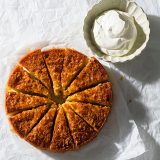Undulating crescent harbors where green water laps at stone bulwarks that eventually give way to pebbled beaches, waves crashing and washing, snorkelers popping up unexpectedly with fistfuls of sea urchins. It’s the coast—rather, the lifeblood—of Chania, a modest town wedged onto the northwest corner of Crete, the largest of the Greek islands.
It also is where chef and now-London transplant Marianna Leivaditaki spent an almost ridiculously idyllic childhood, working in her parents’ restaurant perched above that same shoreline, cleaning the seafood her fisherman father hauled from the waters each morning, learning and loving the inescapable bonds between ocean and table, family and friends.
But on this day, Leivaditaki and I uncharacteristically turn our backs to the Aegean Sea to look inland, a place of soaring peaks and deep olive tree-lined valleys. My weeklong tutorial in Cretan food at her hands now takes us to the height of Mount Psiloritis, part of the highest peak on the island, an almost lunar landscape of hardscrabble shrubbery, lichen and goats lounging in wiry trees.
There, we find Papa Andreas, a priest in a black T-shirt with a blue bandanna wrapped snugly around his head. There, views stretch miles. There, he honors the traditions of shepherds past, mastering the art of mitato, their stacked-stone domed shelters. There, he revives their recipes for goat seasoned simply and roasted over open fires, churning milk into fabulously briny cheeses.
We set to cooking quickly, but not before we share some cheese and raki, the island’s grape-based liquor, a relative of ouzo. “Because we have two legs, we have two raki,” he explains, pouring multiple glasses. “So we have a better journey.”
The first lesson is from his cook, Magda Hnari, who sets up a table inside the cool and dark mitato, then rolls fresh phyllo thinner, thinner and thinner. She’s one of 10 children, and she grew up watching her mother roll out phyllo until it was paper thin, a small ball of dough eventually stretched until almost transparent and draping over the edges of the kitchen table.
I’m mostly familiar with phyllo layered in syrupy baklava, or with spinach and feta for spanakopita. This is different. Hnari leaves her phyllo a little thicker, then mounds small balls of fresh goat cheese over it at intervals. A second sheet of dough goes over before she uses a tiny wooden bowl to cut and seal what look to me like ravioli or dumplings, but Hnari calls pies.
A quick dip in sizzling olive oil and the pies emerge creamy, warm and equally crisp and tender. I could have eaten them by the dozen. It never occurred to me that phyllo could be used this way.
But my lessons in fresh ways with the ubiquitous Greek pastry aren’t over. Leivaditaki wants to show me portokalopita, a cake, of sorts. It’s a cake where we might use flour, but Cretans use fistfuls of papery phyllo, stirring it with eggs and yogurt and spices to create a batter almost pancake-like. Light and layered, it serves as the perfect foil for the bay leaf- and citrus-infused syrup poured over when it emerges from the oven. The result is warm and bright, a brilliant balance to the sweet, moist cake.
It’s a recipe Leivaditaki knew well, but never baked to her satisfaction. The syrup—such a common thread in Greek desserts—too often made the cake heavy and sodden. That is, until a friend’s mother showed her another approach—cutting the phyllo into strips and toasting them in the oven before proceeding with the recipe. Not only was the texture better, the oven step also added a toasted richness to the finished cake.
And then there is the ease of it all. That day, we cooked it on a mountaintop in an outdoor wood-fired oven surrounded by random goats. Imprecise baking, at best. Yet the cake turned out brilliantly, light, sweet and layered with spice. A true testament to the ease of this treat.
Broken Phyllo Cake with Orange and Bay
In Crete, Marianna Leivaditaki showed us how to transform a heap of flaky strips of phyllo dough into a luscious cake soaked in orange syrup.
Photos: Christos Manioros; Styling: Christine Tobin








